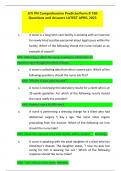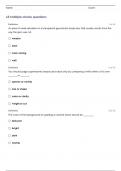ATI Med Surg test questions Fluid and
Electrolytes Balance and Disturbance-With
100% verified solutions-2023-2024
Answer Key
Question 1: An elderly client takes 40 mg of Lasix twice a day. Which electrolyte
(see full question) imbalance is the most serious adverse effect of diuretic use?
You selected: Hypokalemia
Correct
Explanation: Hypokalemia (potassium level below 3.5 mEq/L) usually indicates a
defict in total potassium stores. Potassium-losing diuretics, such as loop
diuretics, can induce hypokalemia.
Reference: Hinkle, J.L., and Cheever, K.H. Brunner & Suddarth's Textbook of
Medical-Surgical Nursing, 13th ed. Philadelphia: Lippincott Williams &
Wilkins, 2014, Chapter 13: Fluid and Electrolytes: Balance and
Disturbance, p. 255.
Chapter 13: Fluid and Electrolytes: Balance and Disturbance - Page
255
Question 2: The nurse is reviewing client lab work for a critical lab value. Which
(see full question) value is called to the physician for additional orders?
Correct response: Potassium: 5.8 mEq/L
Explanation: Normal potassium level is 3.5 to 5.5 mEq/L. Elevated potassium levels
, can lead to muscle weakness, paresthesias, and cardiac dysrhythmias.
Reference: Hinkle, J.L., and Cheever, K.H. Brunner & Suddarth's Textbook of
Medical-Surgical Nursing, 13th ed. Philadelphia: Lippincott Williams &
Wilkins, 2014, Chapter 13: Fluid and Electrolytes: Balance and
Disturbance, p. 254.
Chapter 13: Fluid and Electrolytes: Balance and Disturbance - Page
254
Question 3: A client with pancreatic cancer has the following blood chemistry
(see full question) profile: Glucose, fasting: 204 mg/dl; blood urea nitrogen (BUN): 12
mg/dl; Creatinine: 0.9 mg/dl; Sodium: 136 mEq/L; Potassium: 2.2
mEq/L; Chloride: 99 mEq/L; CO2: 33 mEq/L. Which result should the
nurse identify as critical and report immediately?
You selected: Potassium
Correct
Explanation: The nurse should identify potassium: 2.2 mEq/L as critical because a
normal potassium level is 3.8 to 5.5 mEq/L. Severe hypokalemia can
cause cardiac and respiratory arrest, possibly leading to death.
Hypokalemia also depresses the release of insulin and results in glucose
intolerance. The glucose level is above normal (normal is 75 to 110
mg/dl) and the chloride level is a bit low (normal is 100 to 110 mEq/L).
Although these levels should be reported, neither is life-threatening. The
BUN (normal is 8 to 26 mg/dl) and creatinine (normal is 0.8 to 1.4
mg/dl) are within normal range. (less)
,Reference: Hinkle, J.L., and Cheever, K.H. Brunner & Suddarth's Textbook of
Medical-Surgical Nursing, 13th ed. Philadelphia: Lippincott Williams &
Wilkins, 2014, Chapter 13: Fluid and Electrolytes: Balance and
Disturbance, p. 255.
Chapter 13: Fluid and Electrolytes: Balance and Disturbance - Page
255
Question 4: Which nerve is implicated in the Chvostek’s sign?
(see full question)
You selected: Facial
Correct
Explanation: Chvostek’s sign consists of twitching of muscles supplied by the facial
nerve when the nerve is tapped about 2 cm anterior to the earlobe, just
below the zygomatic arch.
Reference: Hinkle, J.L., and Cheever, K.H. Brunner & Suddarth's Textbook of
Medical-Surgical Nursing, 13th ed. Philadelphia: Lippincott Williams &
Wilkins, 2014, Chapter 13: Fluid and Electrolytes: Balance and
Disturbance, p. 259.
Chapter 13: Fluid and Electrolytes: Balance and Disturbance - Page
259
Question 5: A client has the following arterial blood gas (ABG) values: pH, 7.12;
(see full question) partial pressure of arterial carbon dioxide (PaCO2), 40 mm Hg; and
bicarbonate (HCO3–), 15 mEq/L. These ABG values suggest which
disorder?
You selected: Metabolic acidosis
Correct
Explanation: This client's pH value is below normal, indicating acidosis. The HCO 3–
value also is below normal, reflecting an overwhelming accumulation of
acids or excessive loss of base, which suggests metabolic acidosis. The
PaCO2 value is normal, indicating absence of respiratory compensation.
These ABG values eliminate respiratory alkalosis, respiratory acidosis,
and metabolic alkalosis. (less)
Reference: Hinkle, J.L., and Cheever, K.H. Brunner & Suddarth's Textbook of
Medical-Surgical Nursing, 13th ed. Philadelphia: Lippincott Williams &
Wilkins, 2014, Chapter 13: Fluid and Electrolytes: Balance and
Disturbance, p. 268.
Chapter 13: Fluid and Electrolytes: Balance and Disturbance - Page
268
Question 6: The nurse is caring for a client with laboratory values indicating
(see full question) dehydration. Which clinical symptom is consistent with the
dehydration?
You selected: Dark, concentrated urine
Correct
Explanation: Dehydration indicates a fluid volume deficit. Dark, concentrated urine
indicates a lack of fluid volume. Adding more fluid would dilute the
urine. The other options indicate fluid excess. (less)
, Reference: Hinkle, J.L., and Cheever, K.H. Brunner & Suddarth's Textbook of
Medical-Surgical Nursing, 13th ed. Philadelphia: Lippincott Williams &
Wilkins, 2014, Chapter 13: Fluid and Electrolytes: Balance and
Disturbance, p. 246.
Chapter 13: Fluid and Electrolytes: Balance and Disturbance - Page
246
Question 7: To compensate for decreased fluid volume (hypovolemia), the nurse can
(see full question) anticipate which response by the body?
You selected: Tachycardia
Correct
Explanation: Fluid volume deficit, or hypovolemia, occurs when the loss of
extracellular fluid exceeds the intake of fluid. Clinical signs include
oliguia, rapid heart rate, vasoconstriction, cool and clammy skin, and
muscle weakness. The nurse monitors for rapid, weak pulse and
orthostatic hypotension. (less)
Reference: Hinkle, J.L., and Cheever, K.H. Brunner & Suddarth's Textbook of
Medical-Surgical Nursing, 13th ed. Philadelphia: Lippincott Williams &
Wilkins, 2014, Chapter 13: Fluid and Electrolytes: Balance and
Disturbance, p. 245-246.
Chapter 13: Fluid and Electrolytes: Balance and Disturbance - Page
245
Question 8: Air embolism is a potential complication of IV therapy. The nurse
(see full question) should be alert to which clinical manifestation associated with air
embolism?
You selected: Chest pain
Correct
Explanation: Manifestations of air embolism include dyspnea and cyanosis;
hypotension; weak, rapid pulse; loss of consciousness; and chest,
shoulder, and low back pain. Jaundice is not associated with air
embolism. (less)
Reference: Hinkle, J.L., and Cheever, K.H. Brunner & Suddarth's Textbook of
Medical-Surgical Nursing, 13th ed. Philadelphia: Lippincott Williams &
Wilkins, 2014, Chapter 13: Fluid and Electrolytes: Balance and
Disturbance, p. 280.
Chapter 13: Fluid and Electrolytes: Balance and Disturbance - Page
280
Question 9: The nurse is analyzing the arterial blood gas (AGB) results of a patient
(see full question) diagnosed with severe pneumonia. Which of the following ABG results
indicates respiratory acidosis?
Correct response: pH: 7.20, PaCO2: 65 mm Hg, HCO3–: 26 mEq/L
Explanation: Respiratory acidosis is a clinical disorder in which the pH is less than
7.35 and the PaCO2 is greater than 42 mm Hg and a compensatory
increase in the plasma HCO3– occurs. It may be either acute or chronic.






